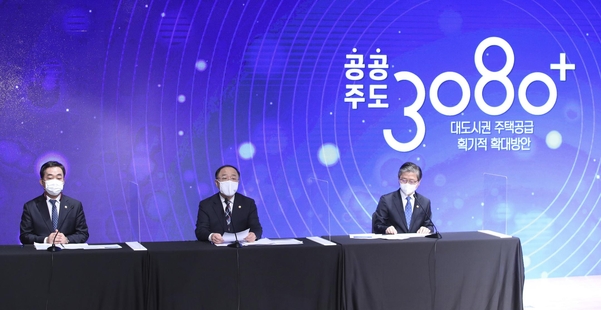Input 2021.02.05 10:00

By region, Seoul has no planned volume ▲Gyeonggi-Incheon 180,000 houses ▲ Metropolitan City 56,000 houses ▲Other regions 27,000 houses. In Gyeonggi and Incheon, new housing sites will be developed in areas with good accessibility to Seoul, and in other regions near metropolitan cities.
Minister of Land, Infrastructure and Transport Byun Chang-heum announced the supply plan the day before and said, “Most of the locations have been confirmed, but they did not disclose their specific location for fine zoning and complete agreement with local governments.” “As soon as the consultations with local governments are completed, two generations in the first half of this year It will be announced in turn.”
As the Ministry of Land, Infrastructure and Transport and LH (Korea Land and Housing Corporation) are managing a list of candidate sites for new housing sites, it is expected that the designation of new housing sites will come from the previously discussed candidate sites.
The most prominent places the mayor pays attention to are Gwangmyeong and Siheung districts (Gahak-dong, Gwangmyeong-si, Guarim-dong and Mujinae-dong, Siheung-si, etc.), which were selected as the Bogeumjari housing district at the time of the Lee Myung-bak administration and then canceled. The area reached 17.4 km2, and 94,000 households were planned at that time. The area of Bundang City is 19.6 km2. It was designated as a district in 2010, but was lifted in 2014 due to a recession in the housing market. It is evaluated that it is’powerful’ in that it was also selected as a candidate for the 3rd new city and that it is difficult to find such a large housing area near Seoul.
At the time the Bogeumjari Housing District was promoted, some residents met opposition, but there is a possibility that the government will adjust the existing public housing district or remove only a part of it to create a’mini new city’ in order to promote the project quickly. It is evaluated as the closest location to southwestern Seoul, such as Yeouido in Gyeonggi-do. It has the advantage of having a wide-area transportation network such as KTX Gwangmyeong Station and Seoul Ring Road.
The market expects the Hanam Gambuk district (Gambuk-dong, Gamil-dong, Gwangam-dong, and Choi-dong) as candidates. Like the Gwangmyeong and Siheung districts, it was lifted from the Bogeumjari housing district. It was designated as the 4th Bogeumjari Housing District in 2010, but was canceled in 2015. At the time, it was planned to have a total area of 2.67 million square meters and 20,000 households. It is close to Jamsil and Wirye new towns in Seoul, and the subway line 9 extends to the nearby area (Jungang Veterans Hospital Station), which is attracting attention as a hinterland demand in the Gangnam area.
Gimpo Gochon-eup area is also discussed. It is a place that was selected as a strong candidate when the 3rd new city was announced, so there is a possibility of’re-admission’. The 3rd new town announced earlier has a high proportion of the Wangsuk district in Namyangju (11.34 million m2) and the Gyosan district in Hanam (6.44 million m2), and it is expected that they will develop near the west as they are concentrated in the east of Seoul. The whole area of Gochon-eup is located at the entrance of Gimpo-si and faces Gangseo-gu, Seoul. It is expected to be able to meet the demand for office workers commuting to Yeouido or Magok district in Gangseo-gu.
Joon-seok Ko, adjunct professor at Dongguk University’s Graduate School of Law, said, “Because the development of new residential sites requires the provision of a wide-area transportation network, considering the cost and time issues, it is likely that new housing sites will be designated around the surrounding areas where the existing wide-area transportation network was established.” “When the Sinansan Line (Siheung City Hall Station ~ Gwangmyeong Station) is built, the Gwangmyeong and Siheung areas will be influential.”
Dae-Jung Kwon, professor of the Department of Real Estate at Myongji University, said, “It is difficult to predict which area will be designated as the designation of new housing sites has often come out from the expected places.” I think there is a possibility in the Gwangmyeong·Siheung area discussed in the past, the Gambuk district in Hanam, and the Gochon-eup area in Gimpo,” he said.
Sim Gyo-eon, a professor at Konkuk University’s Department of Real Estate said, “Because the government is promoting rapid housing supply, it is highly likely that new housing sites will be designated mainly in places where the base survey was completed to develop into past housing districts, such as Gwangmyeong and Siheung districts and Hanam Gambuk districts.” .
